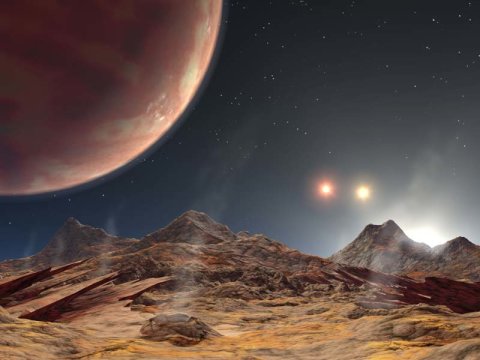Astronomers from the University of Notre Dame have discovered a system in which a "hot Jupiter" type planet orbits a three-star system, a phenomenon that has so far been documented very few times

Artist rendering of a hypothetical moon orbiting a planet discovered in a dense three-star system.
Clear images of "hot Jupiter" taken by physicists at the University of Notre Dame have confirmed that a newly discovered planet is in a three-sun system, a phenomenon that has so far been documented only a few times.
Justin Karp, a physics research fellow at the University of Notre Dame was part of the team that discovered KELT-4Ab, a "hot Jupiter" type star so called because it is a gas giant, but unlike Jupiter, which is relatively distant from the Sun, it orbits one of the suns in its solar system in close proximity. The discovery was published in the Astrophysical Journal.
The KELT (Kilodegree Extremely Little Telescope) telescope discovered the presence of a planet that today is known as KELT-4Ab, located about 685 light years from Earth. Karp was able to take a clear picture of the system and discovered that the planet is actually part of a triple solar system, one of the few planets discovered in a triple system so far.
KELT tracks bright stars over a large area of the sky, looking for planets orbiting their sun at close range. Because KELT-A dims every few days, the scientists estimated that they were witnessing the orbiting planet up close. Karp was asked to use the Keck Observatory to photograph the suspect star, then discovered that two other stars (suns) were participating in the process.
"I discovered a spot nearby, which we believed to be a star, which makes the system a double," said Karp. "And after a deeper examination I discovered that it is actually two points. We would never have suspected it if it weren't for the photos."
KELT-4Ab, 1.5 times larger than Jupiter, orbits the system's main star once every three days. The other two stars identified by Karp orbit each other once every 30 years and at the same time orbit together the largest star in the system, and of course the planet orbiting it, once every 4,000 years.
Only four planets have so far been identified in systems containing three stars, and Karp was involved in three of those discoveries. He and his students discovered the first two. "We are trying to learn how planets reach their final orbits around the stars," said Karp. "The discovery has an impact on our understanding of the formation of planets and their evolution." said.
According to Karp, until the mid-nineties, scientists believed that gas giants like Jupiter could only be discovered at a great distance from the star they orbit, such as Jupiter in our solar system, but when the first hot Jupiters were discovered in 1995, the hypothesis was disproved.
Since then, Karp and others have been trying to study the hot justices to find out how they got to these short orbits. The researchers believe that the presence of many stars in the system may serve as a clue to the way in which the planets were placed in their orbits.
"We still believe that they formed far from the star, but in some way migrated to an orbit close to it. We also don't know why they stopped migrating," said Karp. "It is possible that the companion star drives the dynamics of the planets and directs them to their proximity to the Sun."
Thanks to the discovery of another gas giant close to its parent star in a triple star system, Karp says he and his colleagues can begin to compare and understand what they see in other solar systems.
"When you discover a phenomenon for the first time you hunt and collect it. Once you have enough samples, you can start looking for patterns,” says Karp.
NASA is going to launch in 2017 the TESS satellite that will try to find Earth-like planets orbiting their stars in or near the habitable zone.
to the notice of the researchers
https://www.sciencedaily.com/releases/2016/04/160407221715.htm

3 תגובות
If there is a planet that orbits all three - it must be at a huge distance from all three, otherwise its orbit will be unstable. Its distance from all three should be many tens of times the distance between the suns.
There is no planet that will attack only 2 of them. The track is too crazy, completely unstable. If there was one - it must have been thrown into a stable orbit or out.
Therefore, in fact, all the planets in such a system - orbit one of the 3 suns. The distance of the planet's orbit from the nearest sun must be significantly smaller relative to the distance between the suns. Only then will he have stability. Such a distance should be of the order of a few percent relative to the distance between the panes.
No wonder the discovered planet orbits its star in a matter of days. That means she is very close to him. No wonder it was discovered either: a big planet, a small distance. These are easy to spot.
I write all these things from an intuitive understanding of the orbits of planets, moons and stars. This understanding is based on experience, and simulation of the movement of bodies in space.
3 suns gives an option for several variations to the cycle of hot justice.
Does it encompass one of them, or two, or all of them?
Interestingly, the "three-body problem" is a well-known unsolved problem in mechanics. Not long ago, a fictional book with the same name was written that became a bestseller in China.